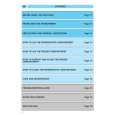|
|
|
Productos
|
|
Información
|
|
Destacado
|
|
|
 |
|
|
No hay comentarios de productos.
SVT450H Bass Amplifier
The Front Panel
1
23
4
5
6
7
8
9
10
11
12
13
1. 0dB (INPUT): The signal output from an instrument (active or passive) or a line level signal may be connected here by means of a shielded instrument cable. 2. PAD: This switch, when depressed, attenuates the input signal by 15dB. Attenuation allows the Gain control (#4) to be used in a more usable (higher) position. If clipping is indicated with the Gain control way down, attenuation is needed. 3. PEAK: This LED illuminates when the signal level into the preamp (excluding the Graphic EQ) approaches clipping. Adjust the Gain control (#4) until a strong signal from your instrument causes this LED to flicker. NOTE: If the LED illuminates frequently with the Gain at a low setting, use the Pad (#2) to attenuate the signal and readjust the Gain. 4. GAIN: Use this control to adjust the level of the signal entering the preamp stage. Adjust this control until the Peak LED (#3) flashes on strong signal peaks (but is not illuminated constantly while playing). To obtain the best signal to noise ratio, set the Gain control as described above and adjust the Master control (#8) to obtain the desired volume level.
5. BASS: Use this control to adjust the low frequency level of the amplifier. This control provides 15dB of cut or 13dB of boost at 40Hz. The low frequency output is flat at the center position. 6. ULTRA MID: Use this control to adjust the midrange frequency level of the amplifier. This control provides 13dB of cut or 5dB of boost at 400Hz. The midrange frequency output is flat at the center position. Rotate the control counter clockwise for a �contoured� sound (more distant, less midrange output) or clockwise for a sound which really cuts through. 7. TREBLE: Use this control to adjust the high frequency level of the amplifier. This control provides 21dB of cut or 16dB of boost at 8kHz. The high frequency output is flat at the center position. 8. MASTER: Use this control to adjust the overall output level of the amplifier. For the lowest possible noise level, adjust the Gain control as described in #4 and use this control to obtain the desired volume level. The Effects Loop and Balanced Out (#20 - 24) are not affected by the Master control.
9. LIMIT: The SVT450H uses an internal Optocoupler Limiter to assist in keeping the amplifier�s output �clean� at extreme volume levels. (All amplifiers may begin to clip their output signals as they approach maximum output levels, resulting in potentially damaging distortion.) To engage the Limiter, depress this switch. The adjacent LED illuminates when the limiter circuit is activated, indicating that the amplifier is nearing full output and the limiter is keeping peak signals from clipping the output. 10. EQ ON: This switch, when depressed, activates the Graphic EQ. The adjacent LED illuminates when the EQ is active. 11. GRAPHIC EQUALIZER: Use these sliders to control the amplitude of the frequencies indicated below each control. The center position of each control is flat: sliding the control upward increases the output level of that frequency; sliding the control downward decreases it. 12. ON: This LED illuminates when the amplifier is on. 13. POWER: Use this switch to turn the amplifier on (top of the switch depressed) and off (bottom of the switch depressed).
4
|
|
 |
> |
|



